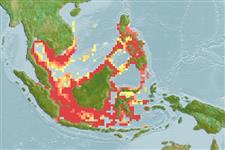>
Clupeiformes (Herrings) >
Engraulidae (Anchovies) > Engraulinae
Etymology: Stolephorus: Greek, stole, -es = garment + Greek, pherein = to carry (Ref. 45335).
More on author: Bleeker.
Environment: milieu / climate zone / depth range / distribution range
Ekologi
laut; payau; amphidromus (Ref. 51243); kisaran kedalaman 0 - 50 m (Ref. 189). Tropical; 17°N - 11°S, 98°E - 127°E (Ref. 189)
Western Pacific: Gulf of Thailand and Java Sea. Indian Ocean records probably based on Stolephorus baganensis or Stolephorus insularis.
Size / Weight / umur
Maturity: Lm ? range ? - ? cm
Max length : 9.5 cm SL jantan/; (Ref. 189)
Duri punggung (Keseluruhan (total)): 0; Duri dubur 0; Sirip dubur lunak: 17 - 18. Belly with 6 or 7 small needle-like pre-pelvic scutes; a small pre-dorsal spine and another spine on the pelvic scute. Maxilla pointed, reaching to or beyond hind border of pre-operculum, the latter concave, indented near maxilla tip. Anal fin short, with origin below about middle of dorsal fin base. A double pigment line on back both before and behind dorsal fin.
A schooling species found in coastal waters. Adults frequently visit the lower reaches of mangroves where neritic conditions are present (Ref. 43081). More specimens and data needed.
Wongratana, T., T.A. Munroe and M. Nizinski, 1999. Order Clupeiformes. Engraulidae. Anchovies. p. 1698-1753. In K.E. Carpenter and V.H. Niem (eds.) FAO species identification guide for fishery purposes. The living marine resources of the WCP. Vol. 3. Batoid fishes, chimaeras and bony fishes part 1 (Elopidae to Linophrynidae). FAO, Rome. (Ref. 9822)
Status IUCN Red List (Ref. 130435)
ancaman kepada manusia
Harmless
penggunaan manusia
Perikanan: perikanan swasembada
informasi lanjut
AcuanBudidaya airprofil budidaya airStrainGenetikaElectrophoresesDiturunkanPenyakit-penyakitPengolahanNutrientsMass conversion
mitraGambarStamps, Coins Misc.Suara-suaraCiguateraKecepatanTipe renangArea insangOtolithsOtakPenglihatan / visi
Alat, peralatan
laporan khas
muat turun XML
Sumber internet
Estimates based on models
Preferred temperature (Ref.
123201): 28.2 - 29.1, mean 28.8 °C (based on 302 cells).
Phylogenetic diversity index (Ref.
82804): PD
50 = 0.5000 [Uniqueness, from 0.5 = low to 2.0 = high].
Bayesian length-weight: a=0.00537 (0.00262 - 0.01101), b=3.17 (2.99 - 3.35), in cm total length, based on LWR estimates for this species & (Sub)family-body (Ref.
93245).
Trophic level (Ref.
69278): 3.3 ±0.4 se; based on size and trophs of closest relatives
Daya lenting (Ref.
120179): Tinggi, Waktu penggandaan populasi minimum kurang dari 15 bulan (K>1).
Fishing Vulnerability (Ref.
59153): Low vulnerability (10 of 100).
Nutrients (Ref.
124155): Calcium = 472 [141, 1,252] mg/100g; Iron = 2.49 [1.36, 4.42] mg/100g; Protein = 19.3 [17.5, 21.2] %; Omega3 = 0.478 [0.207, 1.122] g/100g; Selenium = 45.4 [19.8, 97.1] μg/100g; VitaminA = 38.5 [8.5, 162.7] μg/100g; Zinc = 2.68 [1.74, 3.99] mg/100g (wet weight); based on
nutrient studies.
